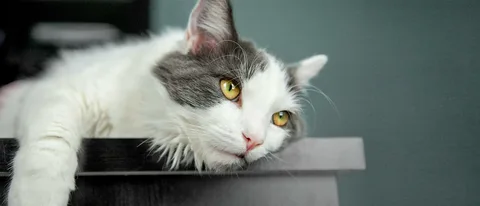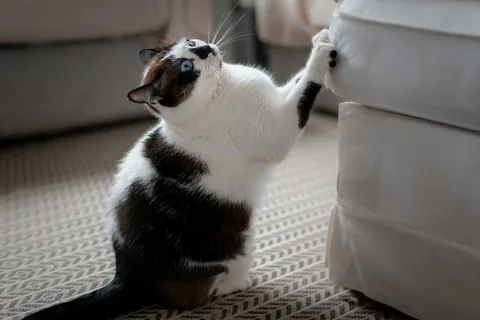Cats are well-known for their curious nature and unique behaviors, and one of the most common yet puzzling actions cat owners often encounter is scratching furniture.
Whether it’s your couch, armchair, or the corners of your wooden furniture, your cat seems determined to leave its mark. But why do cats scratch furniture in the first place?
Understanding the reasons behind this behavior can help you manage it more effectively and prevent damage to your home.
1. Marking Territory
One of the primary reasons cats scratch furniture is to mark their territory.
Cats have scent glands located in their paws, and when they scratch, they release pheromones that signal to other animals, “This is my space.”
Scratching allows cats to leave their scent behind, which is particularly important for them in a multi-pet household or in environments where they feel the need to establish dominance.
It’s their way of saying, “I’m here,” and “This belongs to me.”
Tip:
To manage territorial scratching, provide your cat with designated scratching posts in strategic areas where they tend to scratch the most.
This helps redirect their behavior and ensures they have a space to mark without damaging your furniture.
2. Sharpening Claws
Scratching is a natural and instinctive way for cats to maintain their claws. Just like humans trim their nails, cats need to keep theirs sharp and healthy.
The action of scratching removes the outer layers of the claw, helping to reveal the sharper, newer layer underneath.
This not only keeps their claws in prime condition but also helps them feel more comfortable, especially when climbing or hunting.
Tip:
Regular claw trimming can help reduce the need for cats to scratch excessively. If you’re unsure how to trim your cat’s claws, a veterinarian or groomer can offer guidance.
3. Stretching and Exercise
Scratching is not just about claw maintenance; it also provides an excellent stretch for a cat’s muscles.
When a cat scratches, especially a tall or wide surface, they extend their legs and stretch their bodies.
This movement helps them maintain flexibility and stay physically fit. Cats love to stretch, and scratching allows them to engage in this action while marking their territory.
Tip:
Consider providing vertical scratching posts or cat trees that encourage your cat to stretch and climb.
Cats naturally gravitate toward tall structures, which mimic the action of climbing trees in the wild.
4. Relieving Stress and Anxiety
Cats, like people, experience stress and anxiety. Scratching can serve as a coping mechanism when they are feeling nervous, overstimulated, or bored.
For example, a change in the household, a new pet, or a trip to the vet may prompt your cat to scratch more frequently.
Additionally, when cats are left alone for long periods or are lacking in mental stimulation, they may scratch as a way to release pent-up energy or frustration.
Tip:
Create an enriching environment for your cat by offering puzzle toys, interactive playtime, and cozy spots where they can feel safe. Reducing stress can minimize destructive scratching.
5. Natural Instinct and Play
For kittens, scratching is a normal part of development. It’s a way for them to practice hunting behaviors and sharpen their reflexes.
Even adult cats retain this instinct to scratch as a way to engage with their environment, whether it’s during play or simply to explore their surroundings.
Some cats may scratch out of sheer boredom or curiosity, particularly if they don’t have enough stimulation or engaging activities.
Tip:
Engage your cat in regular play sessions using toys like feather wands, laser pointers, or interactive puzzles.
This provides mental and physical stimulation, which can reduce the likelihood of them turning to your furniture as an outlet.
6. Boredom and Lack of Stimulation
A bored cat will often find ways to entertain itself, and unfortunately, furniture can become the target of this creativity.
Cats are intelligent creatures that need mental and physical stimulation to remain happy. Without access to enriching activities, they may resort to scratching furniture as a way to pass the time.
This behavior is especially common in indoor cats who may not have as many opportunities for exploration.
Tip:
Ensure your cat has plenty of engaging toys, scratching posts, and climbing structures. If your cat is home alone for long periods, consider interactive toys or even a second pet for companionship.

How to Prevent Cats from Scratching Furniture
While scratching is a natural and important behavior, there are several strategies you can implement to minimize the damage to your furniture and redirect your cat’s scratching tendencies.
1. Provide Scratching Posts
Invest in high-quality scratching posts, pads, and furniture specifically designed for cats. Experiment with different materials (e.g., sisal, cardboard, carpet) to see which your cat prefers.
Place the posts near the areas your cat likes to scratch, such as in front of their favorite resting spots or near the couch.
2. Use Deterrents
There are sprays available that discourage cats from scratching furniture, as they often contain scents that cats find unpleasant.
Additionally, you can try placing double-sided tape on the areas your cat tends to scratch—cats dislike the sticky feeling, which may deter them.
3. Regular Claw Trimming
Regularly trim your cat’s claws to reduce the potential for damage. This not only helps prevent destructive scratching but also keeps your cat’s claws healthy.
If you’re unsure how to trim your cat’s claws safely, consult a veterinarian for advice.
4. Positive Reinforcement
When your cat scratches their designated post instead of your furniture, offer praise or a treat.
Positive reinforcement can help reinforce good behavior and make it more likely your cat will choose the scratching post over the couch.
Conclusion
Scratching is a natural and essential behavior for cats, serving purposes from marking territory to keeping their claws healthy and stretched.
While it can be frustrating when they target your furniture, understanding the reasons behind their scratching can help you provide the right outlets for this behavior.
By offering scratching posts, engaging in regular play, and maintaining a stress-free environment, you can ensure both your cat’s well-being and the preservation of your furniture.
So, instead of seeing it as destructive, view scratching as an opportunity to bond with your feline friend and create a comfortable living space for both of you.



